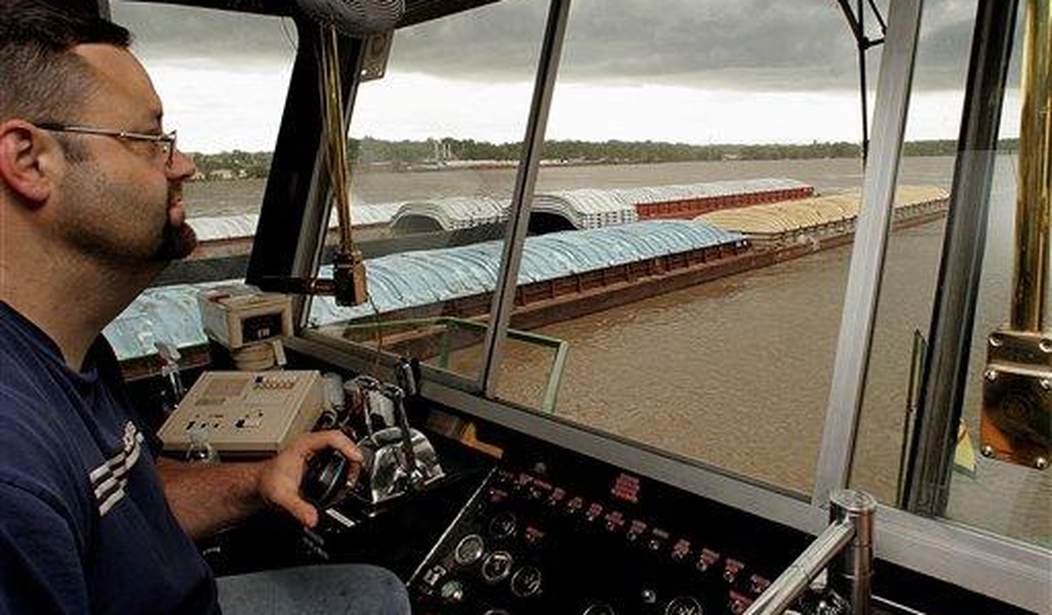As if there weren’t enough supply-side pressures already pummeling the market and, by extension, consumers and the economy, have you heard about the Mississippi lately? He’s not looking as dewy and moist as he normally does this time of year…
This picture is from Vicksburg Mississippi. In normal times, the water would be up to the dock. pic.twitter.com/8RJLEVmein
— Jordan Fife (@JordanFife1) October 12, 2022
In fact, in many places, it’s 15 feet below where it usually is, or there’s no water at all.
A week ago, two sections of the river reopened after dredging operations – not rainfall – got the water level to where barges could traverse the stretches safely. After being closed for darn near a week, the backup was enormous and slow to clear.
…The closures disrupted the flow of newly harvested grain from Midwest farms to export terminals at the U.S. Gulf Coast, where some 60% of corn, soybean and wheat exports exit the country. Northbound shipments of road salt, fertilizer and other goods were also stalled by the closure.
A southbound queue of 22 tow boats hauling 392 barges was still waiting to pass a section of river near Stack Island on Monday morning, but the northbound queue has been cleared, said U.S. Coast Guard spokesman Petty Officer Ryan Graves. There were no vessels waiting to pass near Memphis, he said.
The forecast for the river and its crucial barge traffic is dire moving into fall.
…Traffic remained restricted to one-way only, the Coast Guard said.
Barge draft restrictions that limit the amount of cargo per vessel, and curbs on the number of barges allowed in each tow also remain in place due to low water and a narrowed shipping channel, shippers said.
…The Mississippi River at Memphis is forecast to recede over the next two weeks to multi-year lows, possibly challenging a low-water record set in 1988 by late October, according to the National Weather Service river forecast.
There’s a caveat with those barges – where they normally can have up to a 14-foot draft, they can only have a 9-foot draft now. The river simply isn’t deep enough to handle a loaded vessel with any deeper draft than that, and a grounded barge or boat in a shrunken (or single-width) shipping lane in these conditions can be disastrous.
…After a towboat became lodged near Vicksburg, Miss., earlier this month, barge traffic backed up to a queue of some 1,700 vessels.
The reduced draft requirements engender their own problems with 1) reduced product volume being shipped, meaning more barge trips required, and 2) scarcity of boats meeting that draft requirement means demand is higher, ergo prices per load skyrockets. That is already happening.
A barge headed down the river purchased in the Twin Cities costs over $100 per ton, according to the latest USDA survey. Last October, the cost was less than $35 per ton.

THIS is already happening, too and it should chill everyone to the bone. At the beginning of the Mid-West harvest, freshly harvested grains, corn and soybeans, etc, are having to be stockpiled under tarps by farmers and shippers because they have nowhere and no way to move them without the barges.
Cgb west Memphis bean pile 10/12/22 pic.twitter.com/7wJYpyhiLt
— will nicholson (@wpnicholson3) October 12, 2022
Barges carry as many bushels of grain as 35 train cars or 134 semitrailer trucks, according to the U.S. Army Corps of Engineers.
You can’t make up that kind of volume with trucking or rail, even if both of those were operating at full capacity like they used to, pre-Biden administration. Rail prices are already spiking…

…“Now, companies are paying a premium to move steel, aluminum and other goods by rail and truck, despite cost that are up to five times more than what they’d normally pay by barge.
…and we may still be facing a nation-wide railway strike. Not to mention, if we try the trucks, have you checked the price of diesel lately? If every one of this 134 semis-per-barge is filled with beans/corn, what does transport by truck add to the price?
Mississippi River is so low it is closed to barge traffic so the farmers trying to unload their harvest can't.. our farmers have really taken a beating this year. pic.twitter.com/ItI3FGmfkA
— StringBean01 (@Bean01String) October 9, 2022
Of course, I’m not done yet with the doom and gloom. When the barges get to New Orleans and other Gulf ports, they turn around and do what? Well, they head back north, loaded to the gills with the fertilizers and supplies needed for the next spring. The prices for those were already through the roof this year – Google THAT price shock for our agricultural brethren.

Farmers are sick at heart thinking of the consequences of this blow. Especially if the barges can’t get back up river by the time the winter closes river traffic down.
…What happens downstream affects the whole river chain, including back on Serbus’ farm.
“It’s getting those beans coming down the river and fertilizer up the river,” said Serbus, of the river’s importance.
…According to the U.S. Department of Agriculture, Minnesota farmers on Monday reported harvesting 14% of the corn and 63% of the soybean crop. Many farmers fear the price on stores of fertilizer, which would normally be replenished by upbound cargo vessels, could increase.
“You can see that’ll be an obstacle, if it’s not there already,” Serbus said.
One barge takes nearly four weeks to reach New Orleans from the Twin Cities, says Steenhoek of the Soy Transportation Coalition. Soon, the last barges will shove south, and it’ll be months before higher temperatures bring them up again.
All the while, you have a harvest being brought in that has to sit under tarps if there’s no storage in grain elevators or facilities. What is going to be the spoilage cost of that? Those are perishables – they can’t sit forever. They start to degrade beyond saving at some point. The American farmer is taking in on the chin with a baseball bat, but so are the rest of us in the long run, one way or the other. While I focused on agricultural products, those barges are normally jammed with coal, steel, aluminum, construction materials, gravel/sand, on and on.
Barges and an operating at capacity/full of water Mississippi River and its tributaries are the old “head bone’s connected to the toe bone” song you learned as a kid. I looked for something to quote from the Agricultural Secretary or our fabulous Transportation Secretary placeholder, but…bupkiss. I guess everything’s ice cream cone fine in their world.









Join the conversation as a VIP Member